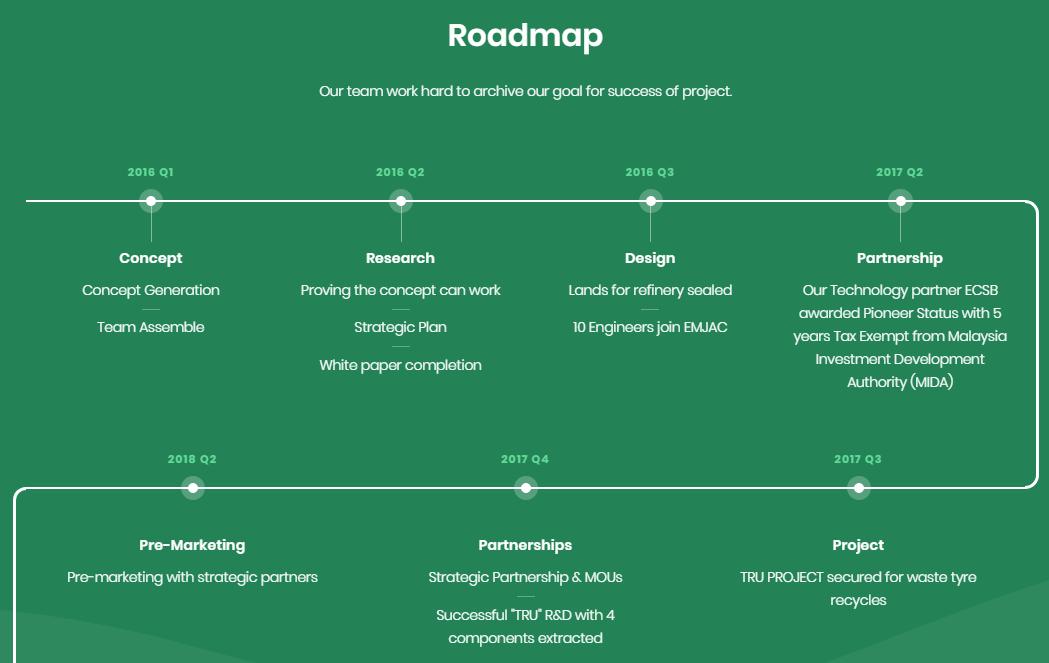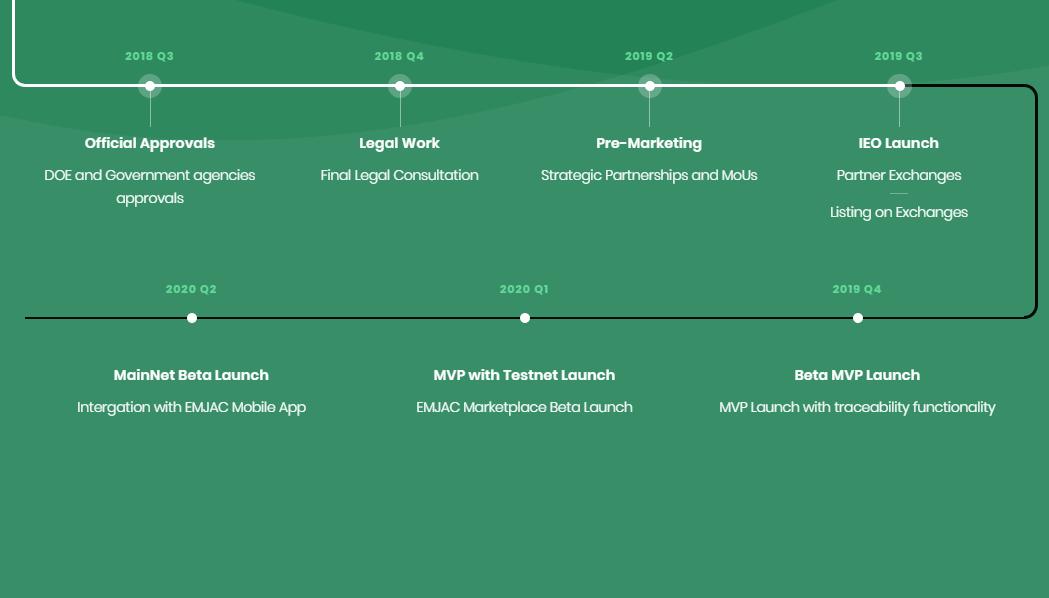EMJAC PROJECT-----The first DLT Green Renewable Energy project in the world.
Every year, 2 billion waste tires are generated worldwide. Less than 30% is recycled and the balance is generally sent to landfills or unloaded illegally. The mishandling of used tires is a serious threat to our environment. EMJAC has created a solution that integrates both the blockchain and green technology to efficiently manage and recycle used tires and provides a global marketing platform for renewable energy products.
Blockchain, which began to emerge as a real-world technology option in 2016 and 2017, is ready to change IT in the same way that open source software did a quarter of a century ago. In the same way that it took Linux more than a decade to become a cornerstone in the development of modern applications, Blockchain will probably take years to become a more economical and efficient way to share information and data between open and private corporate networks.
Blockchain, which began to emerge as a real-world technology option in 2016 and 2017, is ready to change IT in the same way that open source software did a quarter of a century ago. In the same way that it took Linux more than a decade to become a cornerstone in the development of modern applications, Blockchain will probably take years to become a more economical and efficient way to share information and data between open and private corporate networks.
Based on a distributed topology, P2P (peer-to-peer), blockchain or DLT (distributed ledger technology) allows data to be stored on thousands of servers worldwide, allowing anyone on the network to view everyone else's entries in real time This makes it difficult for a user to control or play with the network.
Emjac, in highly publicized incidents during the five years, blockchain has been violated, usually through a cryptocurrency application like Bitcoin. Even the smallest block chains with fewer nodes (or computers) were susceptible to fraud, and potential thieves gained control of most nodes.
However, for companies, blockchain has the promise of transactional transparency: the ability to create secure and real-time communication networks with partners around the world to support anything from retail chains to payment networks, real estate and exchange. of health data.
The recent deployment of this relatively new technology is real because DLT, in essence, represents a new paradigm on how information is shared; Sellers and technology companies, of course, quickly learned how to use DLP (distributed ledger technology) to save administrative time and costs. Many companies have already implemented, or plan to launch, pilot programs and real projects in various sectors, from financial technology (FinTech), to medical care, mobile payments and global shipments.
Boost land conservation through waste for green energy initiatives. Use the latest Blockchain technology to solve the global problem of used tires. Reduce the illegal discharge of used tires. Improve traceability of global exhaust tires from the source to the recycling plant. the percentage of global waste tires recycled with green technology Ensure a long-term sustainable energy supply worldwide Provide a solution and a commercial platform for the supply of waste tires, logistics and the ecosystem to produce
Therefore, although blockchain will not replace traditional corporate relational databases, it will open new doors for the movement and storage of transactional data inside and outside global companies.
Mainly driven by investments in financial technology (fintech), Emjac has experienced a rapid increase in adoption for application development and pilot testing in numerous sectors and will generate more than $ 10.6 billion in revenue by 2023, according to a report by ABI Research. Most of these revenues must come from sales of software and services.

Every year, 2 billion waste tires are generated worldwide. Less than 30% is recycled and the balance is generally sent to landfills or unloaded illegally. The mishandling of used tires is a serious threat to our environment. EMJAC has created a solution that integrates both the blockchain and green technology to efficiently manage and recycle used tires and provides a global marketing platform for renewable energy products.
Blockchain, which began to emerge as a real-world technology option in 2016 and 2017, is ready to change IT in the same way that open source software did a quarter of a century ago. In the same way that it took Linux more than a decade to become a cornerstone in the development of modern applications, Blockchain will probably take years to become a more economical and efficient way to share information and data between open and private corporate networks.
Blockchain, which began to emerge as a real-world technology option in 2016 and 2017, is ready to change IT in the same way that open source software did a quarter of a century ago. In the same way that it took Linux more than a decade to become a cornerstone in the development of modern applications, Blockchain will probably take years to become a more economical and efficient way to share information and data between open and private corporate networks.
Based on a distributed topology, P2P (peer-to-peer), blockchain or DLT (distributed ledger technology) allows data to be stored on thousands of servers worldwide, allowing anyone on the network to view everyone else's entries in real time This makes it difficult for a user to control or play with the network.
Emjac, in highly publicized incidents during the five years, blockchain has been violated, usually through a cryptocurrency application like Bitcoin. Even the smallest block chains with fewer nodes (or computers) were susceptible to fraud, and potential thieves gained control of most nodes.
However, for companies, blockchain has the promise of transactional transparency: the ability to create secure and real-time communication networks with partners around the world to support anything from retail chains to payment networks, real estate and exchange. of health data.
The recent deployment of this relatively new technology is real because DLT, in essence, represents a new paradigm on how information is shared; Sellers and technology companies, of course, quickly learned how to use DLP (distributed ledger technology) to save administrative time and costs. Many companies have already implemented, or plan to launch, pilot programs and real projects in various sectors, from financial technology (FinTech), to medical care, mobile payments and global shipments.
Boost land conservation through waste for green energy initiatives. Use the latest Blockchain technology to solve the global problem of used tires. Reduce the illegal discharge of used tires. Improve traceability of global exhaust tires from the source to the recycling plant. the percentage of global waste tires recycled with green technology Ensure a long-term sustainable energy supply worldwide Provide a solution and a commercial platform for the supply of waste tires, logistics and the ecosystem to produce
Therefore, although blockchain will not replace traditional corporate relational databases, it will open new doors for the movement and storage of transactional data inside and outside global companies.
Mainly driven by investments in financial technology (fintech), Emjac has experienced a rapid increase in adoption for application development and pilot testing in numerous sectors and will generate more than $ 10.6 billion in revenue by 2023, according to a report by ABI Research. Most of these revenues must come from sales of software and services.


Executive team
FOR MORE INFORMATION
Website – https://www.emjac.io/
LinkedIn – https://www.linkedin.com/company/emjac/
Facebook – https://www.facebook.com/EMJToken/
Twitter – https://twitter.com/emjac_emj
Telegram – https://t.me/emjac_emjtoken
Whitepaper – https://emjac.io/assets/emjac_wp.pdf
AUTHOR: oladirano23
BTC LINK https://bitcointalk.org/index.php?action=profile;u=2100363
BTC LINK https://bitcointalk.org/index.php?action=profile;u=2100363



Comments
Post a Comment